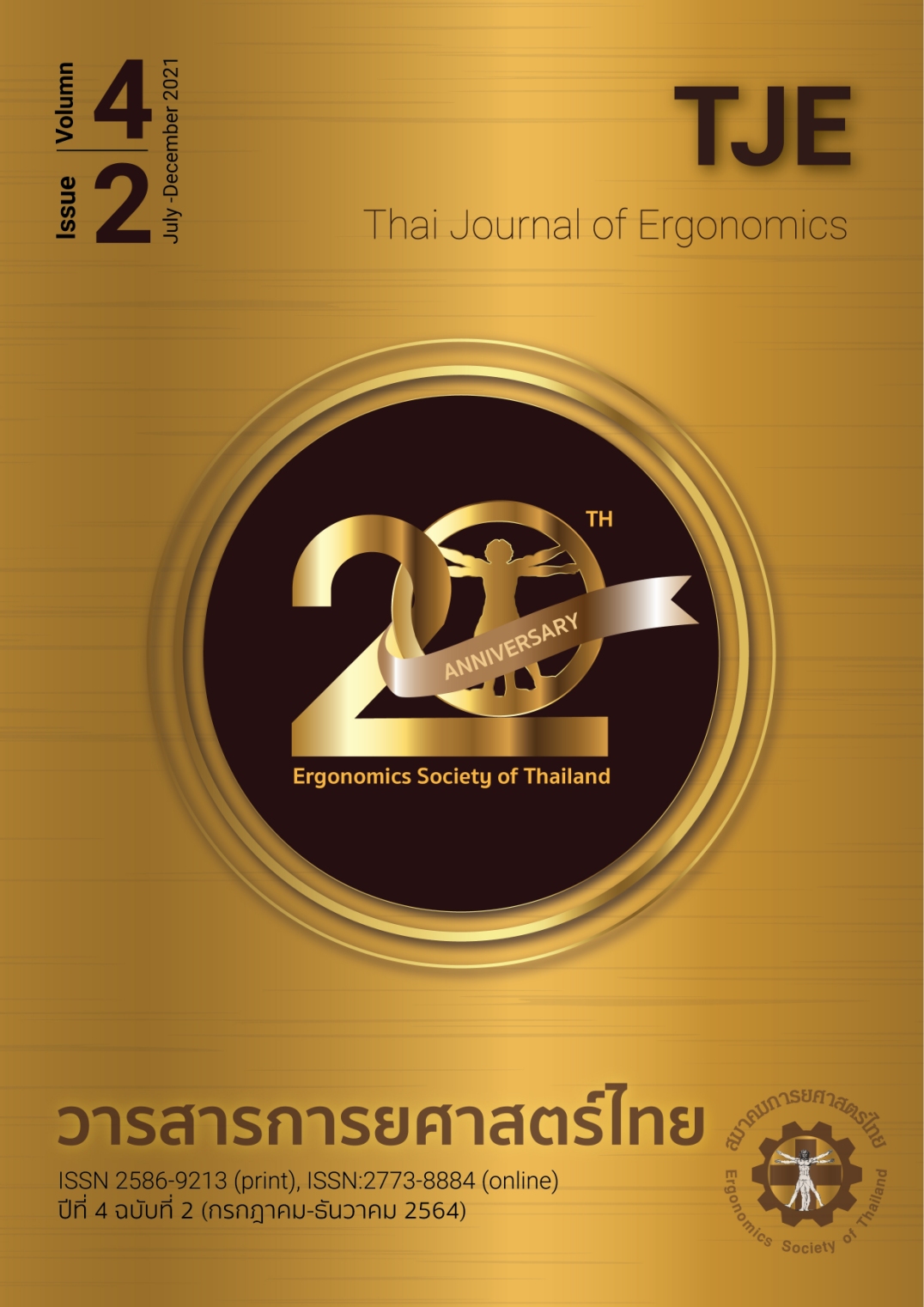ความชุกของอาการผิดปกติทางระบบกระดูกและกล้ามเนื้อ อาการปวดในส่วนต่างๆของร่างกาย และระดับความเครียดที่เกิดจากการทำงานในพนักงานสำนักงาน
Main Article Content
บทคัดย่อ
อาการผิดปกติทางระบบกระดูกและกล้ามเนื้อที่เกิดจากงานพบได้บ่อยในพนักงานสำนักงานซึ่งเป็นอาชีพที่ต้องมีการนั่งทำงานโดยใช้คอมพิวเตอร์เป็นระยะเวลายาวนาน การศึกษาในครั้งนี้มีวัตถุประสงค์เพื่อสำรวจความชุกของอาการผิดปกติทางระบบกระดูกและกล้ามเนื้อ ระดับอาการปวดในแต่ละส่วนของร่างกาย และระดับความเครียดในพนักงานสำนักงานที่ใช้คอมพิวเตอร์ในการทำงานทั้งเพศชายและหญิง จำนวน 561 คน ประเมินโดยใช้แบบสอบถาม Online Self-report Questionnaires on Computer Work-related Exposure (OSCWE) วิเคราะห์ผลการศึกษาโดยใช้สถิติเชิงพรรณนา ผลการศึกษาพบว่า พนักงาน 561 คน มีความชุกของอาการผิดปกติทางระบบกระดูกและกล้ามเนื้อในระยะ 7 วันที่ผ่านมา จำนวน 153 คน (ร้อยละ 27.2) และความชุกในระยะเวลา 12 เดือนที่ผ่านมา จำนวน 187 คน (ร้อยละ 33.3) ระดับของอาการปวดมากที่สุดคือ คอ (VAS=3.56) ไหล่ (VAS=2.76) และหลังส่วนล่าง (VAS=2.07) ส่วนของร่างกายที่มีระดับอาการปวดมากที่สุดใน 7 วันที่ผ่านมา คือ หลังส่วนล่าง ไหล่ และข้อมือ เวลาที่ใช้ในการทำงานคอมพิวเตอร์เฉลี่ย 7.25 ±1.51 ชม./วัน และใช้เวลาในการนั่งทำงานนาน 7.72 ±2.35 ชม./วัน ด้านความชุกของระดับความเครียดพบว่า มีพนักงานตอบข้อคำถามด้านความเครียดจำนวน 422 คน โดยร้อยละ 56.4 มีระดับความเครียดปานกลาง ร้อยละ 21.6 มีระดับความเครียดมาก พนักงานมีความเครียดเฉลี่ย 34.75 ±13.40 คะแนน สาเหตุของความเครียดเกิดจากการกลัวทำงานผิดพลาด ไปไม่ถึงเป้าหมายที่วางไว้ และมีภาวะกล้ามเนื้อตึงปวด ข้อมูลที่ได้จากการศึกษาในครั้งนี้อาจใช้เป็นข้อมูลเบื้องต้นและเป็นแนวทางในการเฝ้าระวัง วางแผน ส่งเสริมและป้องกันการเกิดอาการผิดปกติทางระบบกระดูกและกล้ามเนื้อในกลุ่มพนักงานสำนักงาน และนำไปใช้ในการปรับปรุงงานด้านการยศาสตร์สำนักงานได้
Article Details
เอกสารอ้างอิง
Global Burden Disease. Global burden of 369 diseases and injuries in 204 countries and territories, 1990-2019: a systematic analysis for the Global Burden of Disease Study 2019. Lancet (London, England). 2020;396:1204-22.
Status report of disease and health hazards fron occupational and environmental year 2018 [Internet]. Department of disease control, Ministry of Public Health. 2018 [cited 2021 September 15]. Available from: http://envocc.ddc.moph.go.th/contents/view/790.
Janwantanakul P, Pensri P, Jiamjarasrangsri V, Sinsongsook T. Prevalence of self-reported musculoskeletal symptoms among office workers. Occup Med (Oxford, England). 2008;58:436-8.
Ayanniyi O, Ukpai BO, Adeniyi AF. Differences in prevalence of self-reported musculoskeletal symptoms among computer and non-computer users in a Nigerian population: a cross-sectional study. BMC Musculoskelet Disord. 2010;11:177.
Eltayeb S, Staal JB, Hassan A, de Bie RA. Work related risk factors for neck, shoulder and arms complaints: a cohort study among Dutch computer office workers. J Occup Rehab. 2009;19:315-22.
Hannan LM, Monteilh CP, Gerr F, Kleinbaum DG, Marcus M. Job strain and risk of musculoskeletal symptoms among a prospective cohort of occupational computer users. Scand J Work Environ Health. 2005;31:375-86.
Wahlström J, Lindegård A, Ahlborg Jr G, Ekman A, Hagberg M. Perceived muscular tension, emotional stress, psychological demands and physical load during VDU work. Int Arch Occup Environ Health. 2003;76:584-90.
Kuorinka I, Jonsson B, Kilbom A, Vinterberg H, Biering-Sørensen F, Andersson G, et al. Standardised Nordic questionnaires for the analysis of musculoskeletal symptoms. Appl Ergon. 1987;18:233-7.
Mekhora K, Jalayondeja W, Jalayondeja C, Bhuanantanondh P, Dusadiisariyavong A, Upiriyasakul R, et al. Online self-report questionnaire on computer work-related exposure (OSCWE): Validity and internal consistency. 2014;97(Suppl 7):S80-3.
Mahatnirunkul S, Pumpaisanchai W, Tarpunya P. Suanprung Stress Test-20, SPST-20. Bangkok: Department of Mental Health Ministry of Public Health; 2002.
Jalayondeja C, Jalayondeja W, Mekhora K, Bhuanantanondh P, Dusadi-Isariyavong A, Upiriyasakul R. Break in sedentary behavior reduces the risk of noncommunicable diseases and cardiometabolic risk factors among workers in a petroleum company. Int J Environ Res Public Health. 2017;14:501.
วรรธนะ ชลายนเดชะ, ชุติมา ชลายนเดชะ, เวทสินี แกวขันตี, อัมพร นันทาภรณศักดิ์. ผลของโปรแกรมส่งเสริมกิจกรรมทางกายและเบรกการนั่งนานต่อสุขภาพและสมรรถภาพทางกายของพนักงานในสำนักงาน. วารสารการพยาบาลและสุขภาพ. 2562;13:91-106.
Wongwitwichote K, Jalayondeja W, Mekhora K, Jalayondeja C. Physical activity, sitting time and work-related musculoskeletal disorders in computer workers. Jpn J Ergon. 2017;53(Suppl 2):S450-3.
Klussmann A, Gebhardt H, Liebers F, Rieger MA. Musculoskeletal symptoms of the upper extremities and the neck: a cross-sectional study on prevalence and symptom-predicting factors at visual display terminal (VDT) workstations. BMC Musculoskelet Disord. 2008;9:96.
Luemongkol R, Chaiklieng S. Musculoskeletal disorders and work stress among emergency nurses at the regional hospitals in the northeast of Thailand. Srinagarind Med J. 2014;29:516-23.
Kentawai W, Kongtawelert A, Sujirarat D, Bhuanantanondh P. Prevalence of musculoskeletal disorders among female pottery workers in Khiri Mat, Sukhothai Province, Thailand. J Sci Technol MSU. 2019;38:282-91.
Huysmans MA, Blatter BM, van der Beek AJ. Perceived muscular tension predicts future neck-shoulder and arm-wrist-hand symptoms. Occup Environ Med. 2012;69:261-7.
Paksaichol A, Lawsirirat C, Janwantanakul P. Contribution of biopsychosocial risk factors to nonspecific neck pain in office workers: A path analysis model. J Occup Health. 2015;57:100-9.
Cho CY, Hwang YS, Cherng RJ. Musculoskeletal symptoms and associated risk factors among office workers with high workload computer use. J Manipulative Physiol Ther 2012;35:534-40.
สุธีรา ใจดี, สสิธร เทพตระการพร, สิริมา มงคลสัมฤทธิ์. ความชุกและปัจจัยที่มีความสัมพันธ์ต่อการเกิดอาการทางระบบกระดูกและกล้ามเนื้อในกลุ่มพนักงานทำความสะอาดของมหาวิทยาลัยธรรมศาสตร์. วารสารการส่งเสริมสุขภาพและอนามัยสิ่งแวดล้อม 2560;40:82-94.


